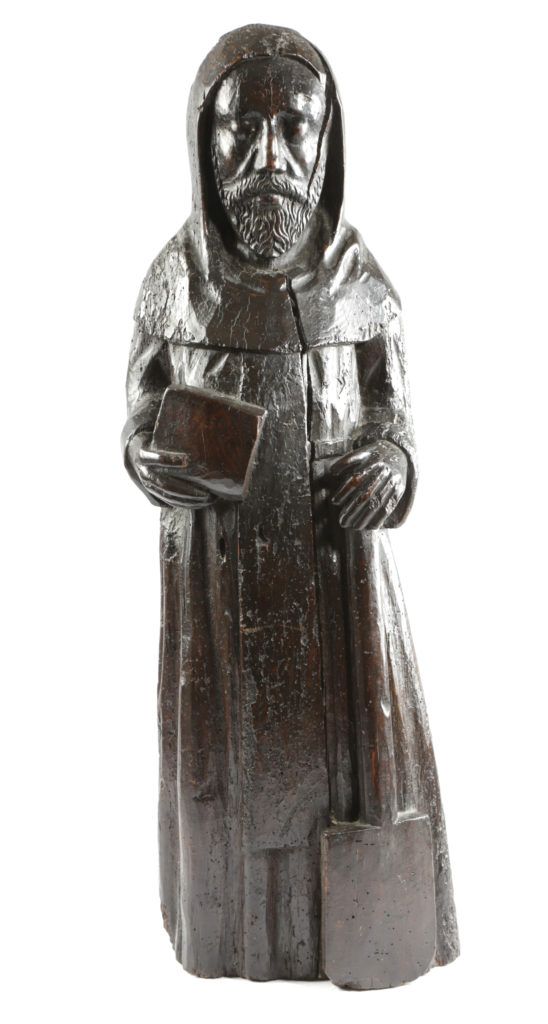 The figurine of St Fiacre which went for £15,750 (picture courtesy of Woolley & Wallis)
The figurine of St Fiacre which went for £15,750 (picture courtesy of Woolley & Wallis)A RARE 15th century medieval elm carved figure of Saint Fiacre, the Irish priest, abbot, hermit and gardener of the 7th century, sold at English auctioneers Woolley & Wallis this month for £15,750 - three times its auction estimate of £1,000-£1,500.
The Irish priest's fame rested on his missionary to France.
Legend has it that Cork-born holy man had a vision telling him to go from Ireland to France to spread the Gospel. He eventually founded a small monastery in the Diocese of Meaux, which became something of a sanctuary owing to Fiacre's gift at gardening.
He was able to grow medicinal plants and flowers that became renowned for their healing powers. Word spread that willow trees in the area cured headaches — but this was, in fact, nothing new; all willow trees contain salicin, which the body converts to salicylic acid and, hey presto! you have aspirin. This cure for headaches via the willow tree has been known for millennia, but Fiacre apparently spread this knowledge to the people in the area — according to local legend.
Through time, Fiacre became a revered figure in France, and appears in statues, icons and paintings.
The carved figure which sold at auction in southwest England stands at 83cm tall and presents him wearing a hood over his habit and holding a bible and spade.
It was offered in The Howard Collection of Oak and Works of Art in Woolley & Wallis’ Furniture and Collections sale on April 9th, 2025.
Commenting on the exceptional price that the statuette went for, specialist at Woolley & Wallis, Mark Yuan-Richards, said: “We saw competitive bidding today for this rare figure of Fiacre, who still resonates in Ireland today, as the patron saint of gardening and healing. He symbolised calmness through nature, which is something as poignant today as it was during his lifetime and the fine carving only added to its appeal.”
St. Fiacre
Feast day: September 1:
St. Fiacre, born in Cork in AD 600, isn’t particularly well known in Ireland, but is virtually a household name in France. One of Ireland’s early missionaries, he was generally revered throughout the Marne area as being the embodiment of the ‘simple living, high thinking’ ethos of the Irish monk.
His name was once in everyday use in France; however not because of his spiritual dimension, but for a more prosaic reason - The word "fiacre" referred to a horse-drawn carriage for hire—essentially the ancestor of the modern taxi.
In Paris, fiacres were the first form of public hire vehicles, dating back to the 17th century. They got their name from the Hôtel de Saint Fiacre, an inn in Paris where carriages could be hired. Saint Fiacre was coincidentally the patron saint of gardeners, but because of the inn’s sign, his name became associated with carriages instead.
Over time, “prendre un fiacre” (to take a fiacre) was just like saying “hail a cab” or "grab an Uber" today. The word ''fiacre" eventually fell out of everyday use as motorised taxis took over in the early 20th century.
But the Irishman continues to be patron saint of the French cabbies, and indeed is a very busy old saint indeed - he is also patron of gardeners and is known as “the saint with green fingers”. Rather less poetically he is also patron saint of haemorrhoid sufferers.
King Henry V, on one of his regular jaunts through France, allowed his troops to ransack the shrine of St Fiacre at Meaux, and personally threatened to remove the saint’s remains to London as a reprisal against the Irish who were then opposing him in the French army. Legend has it that Henry eventually contracted haemorrhoids himself (called in France ‘mal de St. Fiacre’), and yes, almost inevitably, he died when one of his piles turned septic - on the Saint’s feast day.
This may be true, but most historians say that he died of dysentery (which can indeed cause haemorrhoids) on August 31st 1422, the day before St Fiacre’s feast day.

